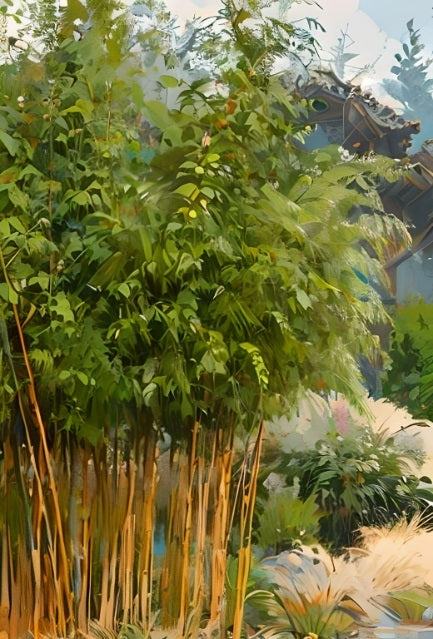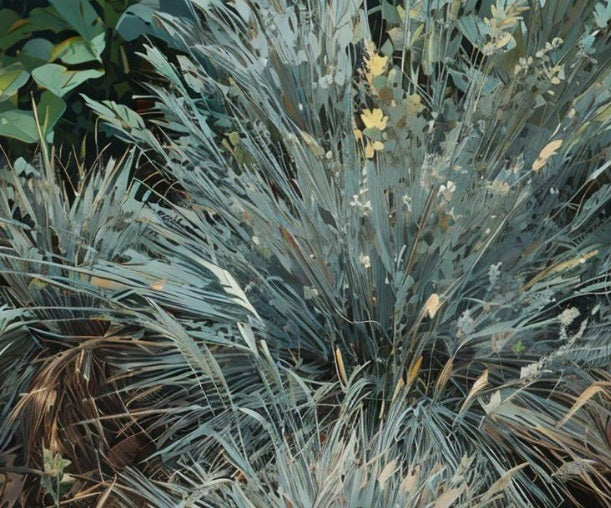Bamboo Seedlings Care
When you receive your seedlings, break the seal and lift the top of the clear plastic plant shipper. Trickle a little lukewarm water onto each rooting cube and exposed roots to replenish any moisture lost during shipping.
Our quality shipping materials provide superior protection for seedlings during transport. It's not uncommon to see bamboo seedlings with some leaves that appear to be fading or browning. This dieback naturally occurs in early bamboo growth and development, as each older stem is sequentially replaced by newly emerging stems. As new thicker and taller stems emerge and develop, the older thinner stems and their leaves begin to die off before being eventually replaced entirely by the vigorous new growth during early development. Regularly prune older, expired leaves and any stems that don't develop newly emerging growth.
Fill half-gallon nursery pots 2/3 full with pre-moistened good quality organic soil mix. We prefer a mix of:
- 8 parts quality organic potting soil (ie Miracle-Gro potting mix)
- 1 part vermiculite (for moisture retention)
- I part perlite (for enhanced aeration)
- 1 measure bone meal per manufacturer’s instructions
Lightly moisten the soil mix. Fill the pot with the soil to about 1-2" below the brim. Create a well in the potting soil that matches the length of the seedling's roots. Carefully remove the rooting cube from the tray, allowing the roots to naturally drop beneath the cube.
Suspend the seedling in the well, with the roots extending downward into the well. First gently add soil to cover the roots, then add more soil around the rooting cube. Lightly tamp the potting soil. The soil should just barely cover the surface of the rooting block. Add a little water to moisten the soil, and add more soil mix as needed to level the soil surface.
Water your bamboo seedlings to maintain consistently moist, but not overly saturated soil. Water only until any excess water first begins to trickle out of the bottom of the pot. When watering the soil surface, use care to avoid unnecessarily disturbing the soil. If watering via the soak method, add water to the tray beneath the pot and allow to soak until surface is moist, then discard any excess water. Don't let your bamboo plants sit in water for extended periods of time -- bamboo does not thrive in soggy conditions.
Bamboo seedlings and plants benefit from a light daily misting of water, especially in low humidity environments. If you observe leaves curling inward, the plant likely requires additional moisture. If leaves are yellowing/wilting, that is often a sign of too much moisture. Leaves that are drying/browning often indicate overexposure to sunlight. Please refer to our Germination Guide for additional troubleshooting information.
In colder climates, maintain your potted bamboo seedlings indoors or in a controlled environment until there is no risk of frost or freeze. Then gradually begin exposing the seedlings to outside conditions, making sure to always avoid any exposure to direct mid-day sun.
Once your seedlings have fully acclimated to your daytime and nighttime outdoor temperatures, you can maintain them outdoors with filtered sunlight. Keep soil moist with regular watering. You can supplement with a diluted fertilizer solution (ie Miracle-Gro or Ironite) per the product instructions for feeding seedlings or new grass. Do not over-fertilize!
When the seedlings have reached a minimum of 12” height, they can be planted in the ground or in outdoor planters after all danger of frost or freeze. If you intend to plant them in a location with plentiful sun, be sure to first incrementally acclimate the young bamboo plants to increasing sunlight before planting in the ground. Young plants should always be protected from intense mid-day sun, keeping in mind that bamboo seedlings growing in a natural bamboo grove in the wild are protected from excessive solar exposure by the overhanging foliage of mature bamboo.
For clumping bamboo, dig a hole at least twice as big as the plant root ball. Add some quality soil/compost to the bottom of the hole, and moisten. Gently remove the bamboo plant from the nursery pot and place in the hole, centered atop the soil/compost layer with the top of the root ball at the base of the plant flush with ground level surrounding the hole.
Infill with soil around the transplant. Gently water and lightly compact the soil as you fill the hole to ground level and even with the base of the transplant. Add an additional layer of quality compost around the base of the plant to retain moisture and protect the roots from excessive temperatures.
For running bamboo planted in the ground, prepare as above and also install seamless bamboo rhizome barrier around the area in which you want the bamboo contained. Follow the manufacturer’s instructions for installation and maintenance. Rhizome barriers are typically recommended to a depth of at least 30” to contain expansive underground roots and rhizomes, with an additional 4-5” of barrier exposed above ground to discourage surface level runners.
Water newly planted bamboo daily for the first month to maintain adequate moisture, and continue doing so during high heat and/or low humidity conditions. Adjust watering accordingly per your climate conditions and temperatures, paying particular attention to sufficient hydration during hot windy weather. Soil should always remain moist, but never soggy. Slow drip methods are effective and efficient in delivering adequate moisture to sufficient depth. Always water at the dripline, not at the base of the plant.
While most bamboo thrive on occasional misting, avoid drenching the foliage of bamboo (or any other plants) with a hose or sprinkler as very little of that water reaches the roots and most of it is lost to surface evaporation. Excessive moisture accumulation on plant leaves and stems encourages fungal, bacterial, and pest issues. Applying sufficient water at ground level directly above the roots is optimal.
As the bamboo plant matures, you can incorporate the shed leaves into the mulch layer at the plant base. Remove excess dead leaves, branches and culms every Spring to encourage new, unobstructed growth and maintain good air circulation and light to discourage mold, fungus, or pest issues.
Refer to our companion article How Fast Does Bamboo Grow? for helpful information with images illustrating the characteristic growth habits of young bamboo plants.
See Cold Weather Bamboo for helpful tips on protecting bamboo from extreme Winter conditions.
Refer to the many helpful articles and videos online about maintaining, pruning, and transplanting bamboo in the landscape; we recommend Bamboo Garden and Bamboo Sourcery as experienced knowledgeable informational resources for maintaining established bamboo. You can also consult with a reputable local bamboo nursery near you for advice specific to growing bamboo in your location's climate, soil, water, and other environmental conditions.
Rev. 112925
Collections
-

All Bamboo Seeds for Sale
Welcome to our catalog of bamboo plant seeds for sale including clumping...
-

All Ornamental Grass Seeds
Grass has finally come into its own as a garden landscape centerpiece....
-

All Flower Seeds
All of our 2025 flower seeds are sold out. Please check back...



